Best AV receivers 2024: Top amps tested by home theater experts Toms Guide We’ve tested the best AV receivers available to buy right now to help you find the cornerstone of your surround sound system. These are our picks of the best powerhouses that deliver big on movie night. Best PicksBy Lee Dunkley last updated 21 June 2024 The best AV receivers tested for power, sound and connectivity — these amps deliver on movie night When you purchase through links on our site, we may earn an affiliate commission.

We’ve tested the best AV receivers available to buy right now to help you find the cornerstone of your surround sound system. These are our picks of the best powerhouses that deliver big on movie night. Best PicksBy Lee Dunkley last updated 21 June 2024
The best AV receivers tested for power, sound and connectivity — these amps deliver on movie night
When you purchase through links on our site, we may earn an affiliate commission. Here’s how it works.
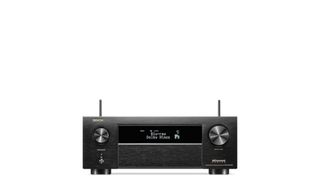 Best overall
Best overall
1.Denon AVR-X4800H View at AmazonView at Sweetwater SoundView at Best BuyThe Denon AVR-X4800H is the best 9-channel AV receiver around. It has ranks top for its elite construction, audio format support and calibration system. It has a rich, layered sound with movies, and also sounds great with music.
Read more below
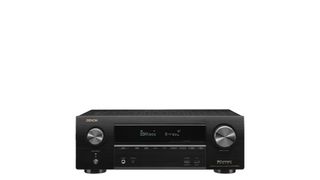 Best value
Best value
- Denon AVR-X2700HView at WalmartView at AmazonView at DreamediaPerfect for smaller rooms, the Denon AVR-X2700H defies expectations and has no problem with big soundtracks, plus it’s nuanced enough to portray ambience too.
Read more below
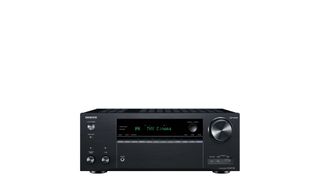 Best 4K/8K support
Best 4K/8K support
- Onkyo TX-NR7100View at AmazonView at CrutchfieldView at Sweetwater SoundThe TX-NR7100 has strong connectivity and supports ultra hi-res, or fast frame rate sources. It’s perfect for gamers, and can be configured for up to 7.1.2 or 5.1.4 Dolby Atmos speakers. It has IMAX Enhanced certification and THX post processing, too.
Read more below
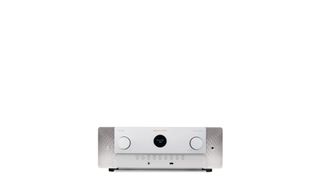 Best format support
Best format support
- Marantz Cinema 50View at AmazonView at Sweetwater SoundView at Best BuyThis is one of the most future proof home theater amps around with feature highlights extending to 8K and 4K @120Hz support, 6 HDMI inputs, and Dolby Atmos, DTS:X and Sony 360 Reality Audio capable. It sounds tremendous with music too.
Read more below
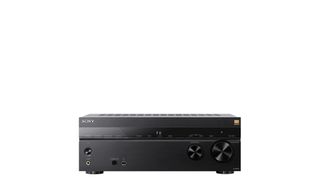 Best for spatial audio
Best for spatial audio
- Sony STR-AN1000View at CrutchfieldView at AmazonView at Sweetwater SoundThis 7.2ch AV receiver supports Dolby Atmos, DTS:X, native 360 Reality Audio and boasts 360 Spatial Sound Mapping to achieve a psycho acoustic effect for the most immersive performance. You need to take care at set-up, but get it right and it’s spectacular.
Read more below
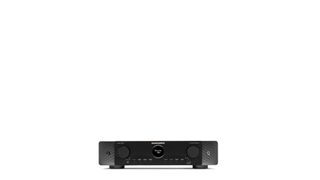 Best low profile
Best low profile
- Marantz Cinema 70SView at CrutchfieldView at Sweetwater SoundView at Best BuyA more compact model than the majority of AV receivers here, this slim Marantz can run 5.1.2 Dolby Atmos and delivers 50W across all 7 channels. It has six HDMI inputs, supports 4K and 8K screens, and comes with HEOS multiroom and AirPlay 2.
Read more below
Load the next products…
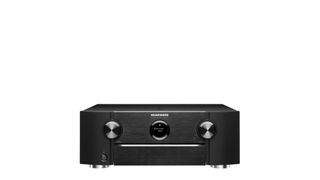 Best for audiophiles
Best for audiophiles
- Marantz SR6015Check AmazonCheck WalmartThis 9 channel AV receiver has sublime audio performance, with effortless control of the soundstage and sonic placement that is always precise. It can be configured for 7.1.2 and supports Dolby Atmos Height Virtualization and Virtual DTS: X, plus IMAX Enhanced certification.
Read more below
About the author

The best AV receivers you can buy right now
Why you can trust Tom’s Guide Our writers and editors spend hours analyzing and reviewing products, services, and apps to help find what’s best for you. Find out more about how we test, analyze, and rate.
Best AV receiver overall
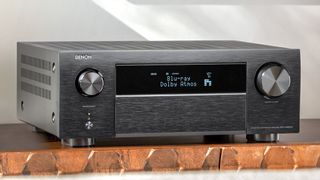

(Image credit: Denon)
1. Denon AVR-X4800H
A future-proof home theater amp that sounds spectacular with all sourcesOur expert review:
Specifications
Dolby Atmos/DTS: X support: YesFeatures: Heos multiroom compatible; Amazon Alexa/Google Assistant; Bluetooth; USB; AirPlay 2Power output (claimed): 9x 125WHDMI: 7x in; 3x outPhono stage input (MM): YesToday’s Best DealsView at AmazonView at Sweetwater SoundView at Best Buy(HDR)
Reasons to buy
+Dolby Atmos, DTS:X, 360 Reality Audio compatible+8K/4K 120Hz HDMI ready+Clean, dynamic performance+Thrilling sound with blockbuster movies
Reasons to avoid
-Classic AVR design not fashion forward-No front mounted HDMI inputDolby Atmos/DTS: X support: YesFeatures: Heos multiroom compatible; Amazon Alexa/Google Assistant; Bluetooth; USB; AirPlay 2Power output (claimed): 9x 125WHDMI: 7x in; 3x outPhono stage input (MM): Yes+Dolby Atmos, DTS:X, 360 Reality Audio compatible+8K/4K 120Hz HDMI ready+Clean, dynamic performance+Thrilling sound with blockbuster movies-Classic AVR design not fashion forward-No front mounted HDMI inputA sonic tour de force, the X4800H is a home theatre amplifier with long-term appeal. The provision of a full board of 8K /4K 120Hz HDMI inputs, and coverage of all the significant home cinema sound formats, ensures that this Denon amp will partner any display or source you might acquire for a long time to come.
The sound profile is best described as visceral. The soundstage is crisp and detailed, but there is a sense of power and precision as well; directional panning is totally convincing. While Denon rates on-board power at 9x 125W (into 8 Ohms) / 200W (into 6 Ohms), it sounds rather more muscular than that. This is a blockbuster amplifier designed for blockbusters but is also darn good with music, sounding light and agile with two-channel stereo and seamlessly immersive with 3D audio mixes.
- Read the full Denon AVR-X4800H review
Best value AV receiver
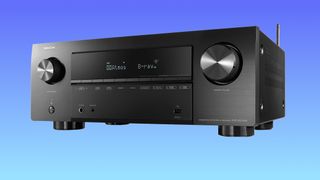

(Image credit: Denon)
2. Denon AVR-X2700H
The best value overallOur expert review:
Specifications
Dolby Atmos/DTS: X support: YesFeatures: Heos multiroom compatible; Amazon Alexa/Google Assistant/Siri voice ; Bluetooth; USB; AirPlay 2Power output (claimed): 7x 150WHDMI: 6x in; 2x outPhono stage input (MM): Yes Today’s Best DealsView at WalmartView at Amazon(Black)View at Dreamedia
Reasons to buy
+Superb value for money+Dynamic, cinematic performer
Reasons to avoid
-Only one HDMI 2.1 inputDolby Atmos/DTS: X support: YesFeatures: Heos multiroom compatible; Amazon Alexa/Google Assistant/Siri voice ; Bluetooth; USB; AirPlay 2Power output (claimed): 7x 150WHDMI: 6x in; 2x outPhono stage input (MM): Yes +Superb value for money+Dynamic, cinematic performer-Only one HDMI 2.1 inputDenon’s AVR-X2700H provides an affordable jumping on point for the brand’s 2021 X-series AV receivers. The price tag hints at budget components, but in a smaller viewing room (rather than a cavernous theater), it defies expectations.
In our listening tests it gave a punchy delivery and has no problem with action-orientated soundtracks, plus it’s nuanced enough to portray subtle ambiance too. Power output is rated at 150W for multichannel, which is generous and it’ll support a 5.1.2 channel configuration or conventional 7.1 surround (depending on how you’ve set up your loudspeakers). There’s also 8K support, albeit via a single HDMI 2.1 input.
Best AV receiver for ultra-hi-res image support
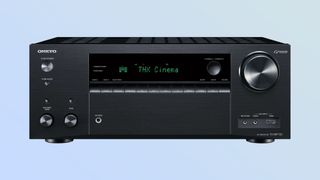
(Image credit: Onkyo)
3. Onkyo TX-NR7100
A 9-channel receiver built for gamers and movie fans alikeOur expert review:
Average Amazon review:☆☆☆☆☆
Specifications
Dolby Atmos/DTS: X support: YesFeatures: Wi-Fi, Bluetooth, Apple Airplay, Chromecast, Alexa, Google AssistantPower output (claimed): 9x 100WHDMI: 6x in; 2x outPhono input stage (MM): YesToday’s Best DealsView at Amazon(Black)View at CrutchfieldView at Sweetwater Sound
Reasons to buy
+Dolby Atmos, DTS:X compatible+Full 8K/4K 120Hz HDMI support+Crisp, dynamic performance+Dirac Live room correction
Reasons to avoid
-Remote control lack backlit buttons -Not overly musicalDolby Atmos/DTS: X support: YesFeatures: Wi-Fi, Bluetooth, Apple Airplay, Chromecast, Alexa, Google AssistantPower output (claimed): 9x 100WHDMI: 6x in; 2x outPhono input stage (MM): Yes+Dolby Atmos, DTS:X compatible+Full 8K/4K 120Hz HDMI support+Crisp, dynamic performance+Dirac Live room correction-Remote control lack backlit buttons -Not overly musicalThe TX-NR7100 is perfectly suited to movie and gaming fans alike. It has strong connectivity for hooking up ultra hi-res, or fast frame rate sources — all 6 HDMI inputs offer 8K and 4K 120Hz playback support. It boasts 100W per channel amplification and can be configured for up to 7.1.2 or 5.1.4 Dolby Atmos loudspeakers. There’s also DTS:X compatibility, plus IMAX Enhanced certification and THX post processing.
Installation is aided by a step-by-step onscreen guide. It’s similar to what we’ve seen on the Denon AVR-X4800H and Marantz Cinema 50 AV receivers, albeit without the polish. There are two options when it comes to Room EQ: Onkyo’s own AccuEQ system, and Dirac Live room correction. Bothe deliver excellent results but Dirac Live was our reviewer’s preference.
THX is a feature that has fallen from favour when it comes to home theater, but it still has value when it comes to upmixing. It brought a huge improvement in staging and storytelling to sci-fi based TV dramas as the THX processing adds scale and extra ambience to onscreen drama.
The AVR also handles complex sound sequences well with satisfying placement of objects and pans from stage left to right. It can sound ominous and heavy with deep rumbles rolling across the soundfield with thunderous LFE (Low Frequency Effects) you can almost feel. Stereo music is less effective and there are better AV receivers with audiophile sensibilities, but when it comes to value, features and overall performance for home theaters, the TX-NR1000 can deliver.
- Read the full Onkyo TX-NR71000 review
Best AV receiver for format support
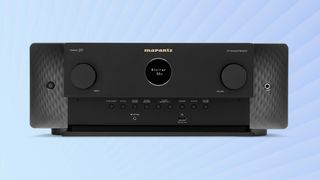
(Image credit: Marantz / Sound United)
4. Marantz Cinema 50
Best format handling and top performance for movie and music fans alikeOur expert review:
Specifications
Dolby Atmos/DTS: X support: YesFeatures: Wi-Fi, Bluetooth, AirPlay2, HEOS, Alexa, Google Assistant, Apple HomePodPower output (claimed): 9x 110WHDMI: 6x in; 3x outPhono stage input (MM): YesToday’s Best DealsView at Amazon(Black)View at Sweetwater SoundView at Best Buy(HDR)
Reasons to buy
+Cool design+Powerhouse performance+HDMI 4k 120Hz support
Reasons to avoid
-No front-mounted HDMI input-High specs come at a high priceDolby Atmos/DTS: X support: YesFeatures: Wi-Fi, Bluetooth, AirPlay2, HEOS, Alexa, Google Assistant, Apple HomePodPower output (claimed): 9x 110WHDMI: 6x in; 3x outPhono stage input (MM): Yes+Cool design+Powerhouse performance+HDMI 4k 120Hz support-No front-mounted HDMI input-High specs come at a high priceThe Marantz Cinema 50 is one of the most future proof home theater amps we’ve seen. The connectivity on offer is truly impressive with 8K and 4K @120Hz support, 6 HDMI inputs plus three outputs, and an impressive auto calibration system. Format support is extensive with Dolby Atmos, DTS:X and Auro 3D capable, as well as Sony’s 360 Reality Audio. It’s also IMAX Enhanced certified, which could come into its own when Disney+ starts streaming IMAX audio mixes.
If you’re looking for an AV amp that can deliver massive dynamics, with whip crack fast transients and a fearsome bass extension, the Cinema 50 doesn’t disappoint. It’s a tremendously exciting listen and steers gunfire shootouts beautifully, with effortless panning, and even at high volume there’s no hint of strain.
It does music well too. Marantz’s lauded HDAM amplification circuitry is warm and melodious. In 2-channel mode, we’d say the Cinema 50 is comparable to a high quality mid range stereo amp, and with strong format support is as future proof as they come right now.
- Read the full Marantz Cinema 50 review
Best AV receiver with spatial audio support

(Image credit: Sony)
5. Sony STR-AN1000
Best for immersive spatial audio mappingOur expert review:
Specifications
Dolby Atmos/DTS: X support: YesFeatures: Wi-Fi, Bluetooth, Apple Airplay, Works with Sonos, Google Chromecast, Spotify ConnectPower output (claimed): 7x 85WHDMI: 6x in; 2x outPhono stage input (MM): NoToday’s Best DealsView at CrutchfieldView at Amazon(Black)View at Sweetwater Sound
Reasons to buy
+Flexible 360 Spatial Sound Mapping wizardry+Impressive sound+360 Reality Audio compatible+Dolby Atmos and DTS:X
Reasons to avoid
-Only two HDMI inputs support 4K 120Hz-Build quality feels a bit cheapDolby Atmos/DTS: X support: YesFeatures: Wi-Fi, Bluetooth, Apple Airplay, Works with Sonos, Google Chromecast, Spotify ConnectPower output (claimed): 7x 85WHDMI: 6x in; 2x outPhono stage input (MM): No+Flexible 360 Spatial Sound Mapping wizardry+Impressive sound+360 Reality Audio compatible+Dolby Atmos and DTS:X-Only two HDMI inputs support 4K 120Hz-Build quality feels a bit cheapThe STR-AN1000 is a 7.2ch AV receiver, which is not only Dolby Atmos and DTS:X enabled but it supports native 360 Reality Audio, and also boasts 360 Spatial Sound Mapping. The latter is particularly interesting, and effectively provides virtual speakers to fill in the gaps. It applies psycho acoustic processing to subjectively move actual speakers into more immersive virtual positions. It can be applied to stereo sources to create a surprisingly convincing multichannel effect, and overlaid on native immersive audio formats like Dolby Atmos, to virtually enhance the soundstage.
Sony quotes a power output of 2x 120W (into 6 Ohms), or roughly 85W per channel. It’s not a volume monster, but will suffice in a typically living room or studio apartment. It’s an exciting listen, with smooth sonic steerage of objects and real sense of drama. It sounds bigger than its power specification implies, and handles blockbusters with authority. Just take care with the set up.
- Read the full Sony STR-AN1000 review
Best AV receiver for small spaces
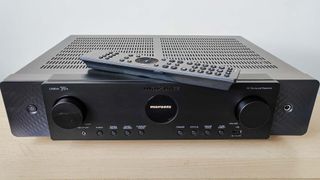
(Image credit: Future)
6. Marantz Cinema 70S
The best slimline AV receiver with a low profileOur expert review:
Specifications
Dolby Atmos/DTS: X support: YesFeatures: HEOS multiroom compatible; Amazon Alexa/Google Assistant ; Bluetooth; USB; AirPlay 2 Power output (claimed): 7x 50W HDMI: 6x in, 1x outPhono stage input (MM): YesToday’s Best DealsView at CrutchfieldView at Sweetwater SoundView at Best Buy(Black)
Reasons to buy
+Slimline design+8K / 4K 120Hz HDMI ready+Punchy cinematic sound
Reasons to avoid
-Only one HDMI output-Only three HDMIs are 8K enabledDolby Atmos/DTS: X support: YesFeatures: HEOS multiroom compatible; Amazon Alexa/Google Assistant ; Bluetooth; USB; AirPlay 2 Power output (claimed): 7x 50W HDMI: 6x in, 1x outPhono stage input (MM): Yes+Slimline design+8K / 4K 120Hz HDMI ready+Punchy cinematic sound-Only one HDMI output-Only three HDMIs are 8K enabledAvailable in silver-gold to U.K. buyers and black only in the U.S. and Australia, the Marantz Cinema 70S is a half-height lifestyle AV receiver perfect for smaller spaces and viewing rooms. The sonic signature has a warm sound that works with hi-res audio as well as movies and gamers.
You can run a 5.1.2 Atmos setup with a uniform 50W delivered across all 7 channels and was peerless with movie soundtracks. In Army of Thieves (Dolby Atmos, Netflix), our reviewer really got the sense that they were travelling into the inner mechanism of the safe when Ludwig Dieter lays his hands on the lock, during the safecracking competition. The clicky travel of the dial is crisply delineated against the symphonic score, which rises all around.
Hooked up to a Fire TV stick listening to Dolby Atmos music mixes from Tidal, our reviewer was thrilled at just how seamlessly the 360 presentation was. Billy Porter’s “Break A Sweat” places the listener firmly in the middle of the dance floor, with horns in the surround, the vocal dead center and the main beat gyrating across the LCR. In our 5.1.2 configuration, there were no sonic gaps or dips with any kind of content, just a totally immersive listening experience.
- Read the full Marantz Cinema 70S review
Best AV receiver for audiophiles
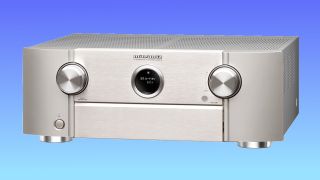
(Image credit: Marantz)
7. Marantz SR6015
This stylish home theatre hero has a musical pedigreeOur expert review:
Specifications
Dolby Atmos/DTS: X support: YesFeatures: HEOS compatible; Amazon Alexa; Siri; Google Assistant support; IMAX EnhancedPower output (claimed): 9x 100WHDMI: 7x in; 3x outPhono stage input (MM): YesToday’s Best DealsCheck AmazonCheck WalmartVisit Site
Reasons to buy
+Hugely precise cinema sound+Excellent two-channel performance
Reasons to avoid
-Only one 8K/4K 120fps inputDolby Atmos/DTS: X support: YesFeatures: HEOS compatible; Amazon Alexa; Siri; Google Assistant support; IMAX EnhancedPower output (claimed): 9x 100WHDMI: 7x in; 3x outPhono stage input (MM): Yes+Hugely precise cinema sound+Excellent two-channel performance-Only one 8K/4K 120fps inputThere’s something enduringly elegant about Marantz’s AV component design. The curved fascia with small porthole display speaks of legacy and old-school musicality. But don’t let that fool you, this AV receiver is also a movie beast on the cutting edge. We found its audio performance to be sublime, with effortless control of the soundstage. Never feeling under pressure, sonic placement is always precise.
A 9 channel model, it can be configured for 7.1.2. There’s also Dolby Atmos Height Virtualization and Virtual DTS: X, plus IMAX Enhanced certification, which means it’ll automatically change bass management handling for deeper bass when it recognises flagged content. The receiver has a single 8K-capable HDMI 2.1 input, while smart support covers Alexa and Google Assistant, as well as AirPlay 2.
Best high-end AV receiver
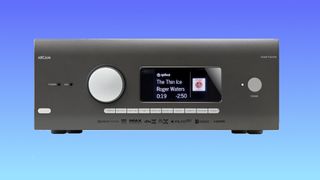
(Image credit: Arcam)
8. Arcam AVR30
The best AV receiver for true home theater connoisseursOur expert review:
Specifications
Dolby Atmos/DTS: X support: YesFeatures: AirPlay 2; Alexa voice controlPower output (claimed): 9x 150WHDMI: 7x in: 3x outPhono stage input (MM): NoToday’s Best DealsCheck AmazonCheck Walmart$6,000 at Audio Advice
Reasons to buy
+Wonderfully, rich and energetic sound+Dirac Live room calibration
Reasons to avoid
-No 8K/4K 120fps support-Usability is a little basicDolby Atmos/DTS: X support: YesFeatures: AirPlay 2; Alexa voice controlPower output (claimed): 9x 150WHDMI: 7x in: 3x outPhono stage input (MM): No+Wonderfully, rich and energetic sound+Dirac Live room calibration-No 8K/4K 120fps support-Usability is a little basicArcam is often cited as the connoisseur’s choice when it comes to home theatre. In addition to the usual list of immersive codecs, this high performing receiver comes with both Auro-3D compatibility and IMAX Enhanced certification. And, while the AVR30 is a 7-channel receiver, there’s processing headroom for 16 channels if you’re prepared to stack up extra amplification.
Calibration is best in class, thanks to Dirac Live, which does a first class job of optimising the AVR’s output to suit your listening room. Less exceptional is the lack of 2.1 compatibility; Arcam is offering a complete board swap, but this is a prohibitively expensive fix. Still, what the AVR30 lacks in mod cons, it makes up for in performance, proving capable of instantaneous highs, and solid plunging lows. Wireless support covers Bluetooth and Wi-Fi, with Google Chromecast and AirPlay 2 talents too.
Specs compared
Swipe to scroll horizontally| Header Cell - Column 0 | Power output (claimed) | Dolby Atmos/DTS: X support | HDMI ports | Phono stage (MM) | |—|—|—|—|—| | Denon AVR-4800H | 9x 125W | Yes | 7x in; 3x out | Yes | | Denon AVR-X2700H | 7x 150W | Yes | 6x in; 2x out | Yes | | Onkyo TX-NR7100 | 9x 100W | Yes | 6x in; 2x out | Yes | | Marantz Cinema 50 | 9x 110W | Yes | 6x in; 3x out | Yes | | Sony STR-AN1000 | 7x 85W | Yes | 6x in; 2x out | No | | Marantz Cinema 70S | 7x 50W | Yes | 6x in, 1x out | Yes | | Marantz SR6015 | 9x 100W | Yes | 7x in; 3x out | Yes | | Arcam AVR30 | 9x 150W | Yes | 7x in: 3x out | No |
How to choose the best AV receiver for you
Buying something as complex and multi-talented as an AV receiver can be overwhelming to a casual consumer, so if you’re serious about transforming your sound output into something more theater-like, start educating yourself on the necessities by familiarizing yourself with the things to consider.
Configuration
Something to know right out of the gate is that most seven-channel AV receivers support a speaker configuration of 5.1.2, which is the standard 5.1 surround layout with two additional height/up-firing speakers. Models that feature nine channels of amplification can be used for either 5.1 with four Dolby height speakers (5.1.4) or 7.1 surround with two height channels (7.1.2). Speaker models such as those in the new Klipsch Reference series could make a great partnership for a home cinema setup, and has several upward-firing height speakers to meet Dolby Amos requirements.
Connectivity
Finding the best AV receiver isn’t just about HDMI inputs. Sure we like plenty of inputs, but the number of outputs are important too, particularly if you plan on running both a flatscreen and a projector in the same room.
If you’re considering an AV receiver as a connectivity hub for a music system as well as movies, then be sure to check out our guide to the best turntables for any budget. Many of the receivers available today come with a built-in moving-magnet phono stage to enable vinyl playback from any of the record decks we’ve tested.
Resolution and frame rate support
Do you need 8K or High Frame Rate HDMIs? If your AV receiver is unlikely to have a games console connected then the answer is no. In which case there’s some great deals to be had on AVRs with regular HDMI 2.0 inputs.
Surround sound
Dolby Atmos compatibility is a given (and by default that means you’ll get DTS:X too), but how many channels do you need? Given the option, 9 channels always trump 7, because it opens up more speaker options such as 5.1.4 or 7.1.2, for example.
Don’t have a full Dolby Atmos home theatre loudspeaker set up? Look for a model that offers height virtualisation technology, so you can enjoy an immersive audio experience even when you don’t have a full set of physical speakers.
Power output
Power isn’t just about roof-raising volume, and even if you’re not lucky enough to have a dedicated movie room, a model with big amplification makes sense. A high power output means an AVR can deliver dynamic transients, and pressure load a space without clipping or strain.
8K AV receivers HMDI 2.1 bug explained

(Image credit: Phil Barker/Future Publishing via Getty Images)While 8K, or more likely 4K at 120fps from a next-gen games console, is a compelling reason to upgrade your dusty old AV receiver, there’s an elephant-sized HDMI bug in the room we need to address.
The first generation receivers with 8K HDMI 2.1 input/s you can buy right now are known to suffer a compatibility issue that means some new 8K/4K source devices that offer a 4K/120fps or 8K video resolution output (we’re looking at you Xbox Series X) do not always pass the video signal through to the display.
This has left the likes of Denon, Marantz and Yamaha scrambling to find a solution. Consequently, Denon is supplying buyers of affected Denon and Marantz AV receivers an HDMI adapter box free of charge. The SPK618 sits between your console and AV receiver, and corrects the HDMI data allowing it to pass. Inelegant perhaps, but effective.
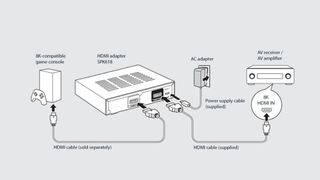
(Image credit: Sound United)An alternate workaround for owners of affected AVRs is to connect their console directly to their 4K/120fps capable TV, and then route audio back to the AVR using the eARC HDMI connection.
Alternatively, gamers can just output from their console at 4K/60fps resolution (effectively the default premium display option anyway) and all will be fine and dandy.
Then again, you could hang fire and wait for new models. Yamaha says its new RX-A8A, RX-A6A and RX-A4A receivers use a next generation HDMI board which isn’t so afflicted.
How we test AV receivers
When testing models for inclusion in our best AV receivers page, we play a range of media — including movies, music and games — in order to evaluate overall sound quality performance. We also test any companion software that may come with an AV receiver, and factor in how easy it is to set up and use each receiver with a reference speaker system.
Other features we consider include the different kinds of connectivity options, all of which determine how well it will work with your home entertainment setup. We also take into account power output, the number of supported audio channels and subwoofer outputs, and available processing software for decoding movie soundtracks as well as their ability to handle music sources — all factors that greatly affect how each speaker will sound in your living room.
Once we complete our testing, we rate each AV receiver based on our five-point system (1 = worst, 5 = best). If a product hits nearly every mark, it’s awarded an Editor’s Choice badge.
More from Tom’s Guide
- What is Dolby Atmos and how to get it in your setup
- Best record players for any budget
- Best movies to watch this weekend
Best deals
Round up of today’s best deals Denon AVR-4800H
Denon AVR-4800H $2,499ViewSee all prices
$2,499ViewSee all prices Denon AVR-X2700H
Denon AVR-X2700H $699$647.99ViewSee all prices
$699$647.99ViewSee all prices Onkyo TX-NR7100
Onkyo TX-NR7100 $1,299$629ViewSee all prices
$1,299$629ViewSee all prices Marantz Cinema 50
Marantz Cinema 50 $2,395ViewSee all pricesSony STR-AN1000
$2,395ViewSee all pricesSony STR-AN1000 $898ViewSee all prices
$898ViewSee all prices Marantz Cinema 70S
Marantz Cinema 70S $1,200ViewSee all pricesWe check over 250 million products every day for the best pricespowered by
$1,200ViewSee all pricesWe check over 250 million products every day for the best pricespowered by
FAQ
Is Onkyo better than Denon?
Is Denon superior to Onkyo? Both brands have carved their niches and are revered in the audio world. Denon is known for precision and features, while Onkyo is synonymous with power and value. Your choice should be dictated by your specific preferences and requirements.Oct 22, 2023
Are AV processors worth it?
While the most powerful receivers can offer around 13 channels at up to around 150W in stereo, with an AV processor and power amp, you can not only up the channel ante but also increase that wattage by a considerable amount to drive all the loudspeakers and subwoofers in home cinema installs of even epic proportions.Jun 15, 2023
What is AV in cinema?
An audiovisual work (AV work) is a series of related images that are capable of being shown by some device, along with any sounds that accompany the visual portion of the work. The audiovisual works category includes movies and films, as well as slide shows, video games, and the like.
Is Denon high end?
Whatever configuration you’re looking for, Denon has the high-end AV receivers and audio equipment you need to create your perfect home theater experience.
Can AV support 4K?
Which HDMI inputs on my AV or AVR support 4K/120 and 8K video resolutions? Any AV or AVR that incorporates a dedicated 8K HDMI input can pass 4K/120 and 8K video resolutions. Only the 8K HDMI input allows pass through for 4K/120 and 8K resolutions directly from the source device.



















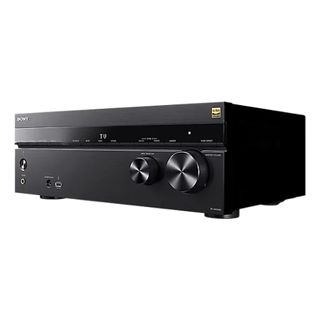 Best overall
Best overall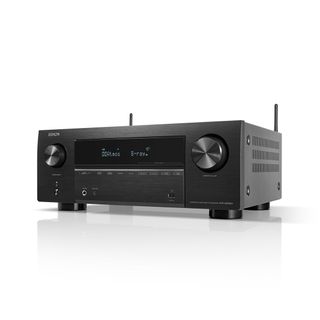 Best budget
Best budget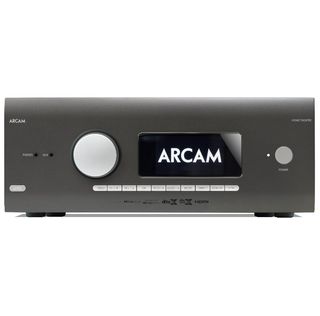 Best mid-range
Best mid-range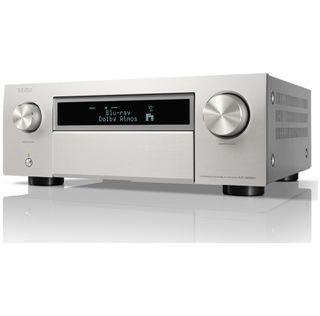 Best premium
Best premium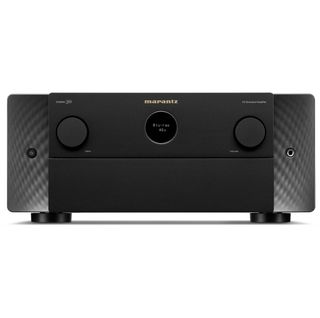 Best high-end
Best high-end Sony TA-AN1000
Sony TA-AN1000 £999£899ViewSee all prices
£999£899ViewSee all prices Denon AVR-X2800H
Denon AVR-X2800H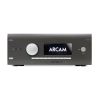 Arcam AVR5
Arcam AVR5 £1,999ViewSee all pricesLow Stock
£1,999ViewSee all pricesLow Stock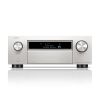 Denon AVC-X6800H
Denon AVC-X6800H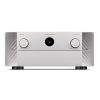 Marantz Cinema 30
Marantz Cinema 30


 Dennis Burger
Dennis Burger Adrienne Maxwell
Adrienne Maxwell



